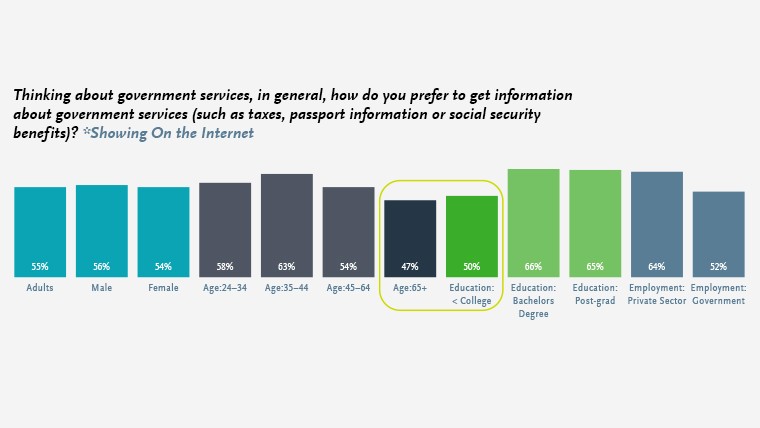

Even though digital government services are designed for speed and improved citizen outcomes, there are populations who aren’t yet convinced of the value it offers. It was especially striking that 6 in 10 (61%) adults perceive that accessing services in person, on the phone, or by mail is faster than accessing them from the internet.
Certain demographics, like the 35-44 age segment, reported a definite preference for online government services. Other demographic groups were less positive. Respondents over the age of 65, along with participants who do not have a college education, were less likely to report that they prefer to use digital government services.

When asked about data privacy in general, 7 in 10 of all respondents are somewhat concerned about protecting their information on the internet. And when comparing digital government to other institutions, 62% of participants stated that they trust financial and healthcare institutions more than government organizations to keep their personal information private.
Interestingly, the device that’s being used to access the internet matters to people. Across all respondents, the most trusted device is a desktop or laptop, perceived as better to protect personal information than mobile phones or tablets. However, 65% of respondents ages 24-34 trust a mobile phone to keep their personal information private, the highest among all age groups when rating devices.
Looking back at 2020, we’ve seen unprecedented feats of modernization. Agencies have amplified their digital services and are accommodating unprecedented levels of demand—enhancing access and outcomes for citizens. Government leaders can now turn to the next chapter of digital government services:
Federal IT leaders are at the vanguard of digital customer experience, creating products that deliver new value with every interaction. And while certain segments continue to prefer non-digital options, other segments are leaning toward a digital-first future. In fact, 40% of the respondents said they would be comfortable with the government eventually keeping a digital profile for them—eliminating the need to input similar information in multiple places and creating a more seamless experience for citizen-government interactions.
Whether or not a digital profile is the future of government, citizens are ready for the pace of change to accelerate and they expect that the Federal Government will deliver emerging capabilities that transform everyday experiences.
About our research partner Morning Consult
Morning Consult is a global data intelligence company, surveying tens of thousands of people across the globe every day.